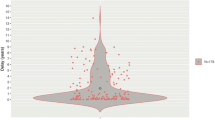Abstract
Introduction
Shunt infection (SI) is an enduring problem in pediatric neurosurgery. Its occurrence is variable in the different series that were published, according to the definition retained. In addition, long-term data, which could help to evaluate the incidence of delayed SI, as well as the developmental outcome after SI, are scarce in the literature.
Materials and methods
We reviewed retrospectively children shunted for hydrocephalus during the last 20 years to evaluate the incidence of SI, including late SI, the risk factors and sources of contamination, and the late outcome after SI.
Results
We treated 1,173 patients who were followed-up for a mean duration of 7.0 years. During that period, 158 patients presented with a total number of 190 episodes of infection, 19 of which occurred more than 1 year after surgery. The infection rates per patient and per procedure were 13.6 and 5.9%, respectively. Age below 4 months at shunt insertion [odds ratio (OR)=1.81], antenatal diagnosis (OR=2.23), myelomeningocele (OR=2.14), and post-hemorrhagic hydrocephalus (OR=1.98) were significantly correlated with SI. SI was mostly due to intraoperative contamination; however, delayed SI was mostly caused by blood-borne contamination and abdominal sepsis. The mortality related to SI was 10.1%; the Glasgow Outcome Score, as well as schooling, was significantly and independently affected by SI.
Conclusion
Long-term follow-up of shunted children is necessary to evaluate the real incidence of SI and the functional outcome after SI.


Similar content being viewed by others
References
Baird C, O’Connor D, Pittman T (1999) Late shunt infections. Pediatr Neurosurg 31:269–273
Bayston R, Lari J (1974) A study of the sources of infection in colonised shunts. Dev Med Child Neurol 16(Suppl 32):16–22
Choux M, Genitori L, Lang D, Lena G (1992) Shunt implantation: reducing the incidence of shunt infection. J Neurosurg 77:875–880
Cochrane DD, Kestle JRW (2003) The influence of surgical operative experience on the duration of first ventriculoperitoneal shunt function and infection. Pediatr Neurosurg 38:295–301
Drake JM, Sainte-Rose C (1995) The shunt book. Blackwell, Cambridge
Drake JM, Kestle JRW, Milner R et al (1998) Randomized trial of cerebrospinal fluid shunt valve design in pediatric hydrocephalus. Neurosurgery 43:294–305
George R, Leibrock L, Epstein M (1979) Long-term analysis of cerebrospinal fluid shunt infections. J Neurosurg 51:804–811
Govender ST, Nathoo N, Van Dellen JR (2003) Evaluation of an antibiotic-impregnated shunt system for the treatment of hydrocephalus. J Neurosurg 99:831–839
Jennett B, Snoek J, Bond MR, Brooks N (1981) Disability after severe head injury: observations on the use of the Glasgow outcome scale. J Neurol Neurosurg Psychiatry 44:285–293
Kaufman BA (2001) Management of complications of shunting. In: McLone DG (ed) Pediatric neurosurgery, 4th edn. Saunders, Philadelphia, pp 529–547
Kulkarni AV, Drake JM, Lamberti-Pasculli M (2001) Cerebrospinal fluid shunt infection: a prospective study of risk factors. J Neurosurg 94:195–201
Mangram AJ, Horna IP, Silver LC, Jarvis WR, Hospital Infection Control Practices Advisory Committee (1999) Guidelines for prevention of surgical infection, 1999. Infect Control Hosp Epidemiol 20:247–280
McGirt MJ, Zaas A, Fuchs HE, George TM, Kaye K, Sexton DJ (2003) Risk factors for pediatric ventriculoperitoneal shunt infection and predictors of infectious pathogens. Clin Infect Dis 36:858–862
Pople IK, Bayston R, Hayward RD (1992) Infection of cerebrospinal fluid shunts in infants: a study of etiological factors. J Neurosurg 77:29–36
Quigley MR, Reigel DH, Kortyna R (1989) Cerebrospinal fluid shunt infections. Pediatr Neurosci 15:111–120
Rekate HL, Ruch T, Nulsen FE (1980) Diphteroid infections of cerebrospinal fluid shunts. J Neurosurg 52:553–556
Renier D, Lacombe J, Pierre-Kahn A, Sainte-Rose C, Hirsch JF (1984) Factors causing shunt infection: computer analysis of 1174 operations. J Neurosurg 61:1072–1078
Schreffler RT, Schreffler AJ, Wittler RR (2002) Treatment of cerebrospinal fluid shunt infections: a decision analysis. Pediatr Infect Dis J 21:632–636
Shurtleff DB, Stuntz JT, Hayden PW (1985–1986) Experience with 1201 cerebrospinal fluid shunt procedures. Pediatr Neurosci 12:49–57
Vinchon M, Lemaitre MP, Vallée L, Dhellemmes P (2002) Late shunt infections: incidence, pathogenesis, and therapeutic implications. Neuropediatrics 33:169–173
Vinchon M, Defoort-Dhellemmes S, Nzeyimana C, Vallée L, Dhellemmes P (2003) Infantile traumatic subdural hematomas: outcome after five years. Pediatr Neurosurg 39:122–128
Vinchon M, Dhellemmes P (2004) Abdominal complications of peritoneal shunts. In: Cinalli G, Sainte-Rose C, Maixner W (eds) Pediatric hydrocephalus. Springer, Berlin Heidelberg New York, pp 315–327
Walters BC, Hoffman HJ, Hendrick EB, Humphreys RP (1984) Cerebrospinal fluid shunt infection. J Neurosurg 60:1014–1021
Author information
Authors and Affiliations
Corresponding author
Rights and permissions
About this article
Cite this article
Vinchon, M., Dhellemmes, P. Cerebrospinal fluid shunt infection: risk factors and long-term follow-up. Childs Nerv Syst 22, 692–697 (2006). https://doi.org/10.1007/s00381-005-0037-8
Received:
Published:
Issue Date:
DOI: https://doi.org/10.1007/s00381-005-0037-8




